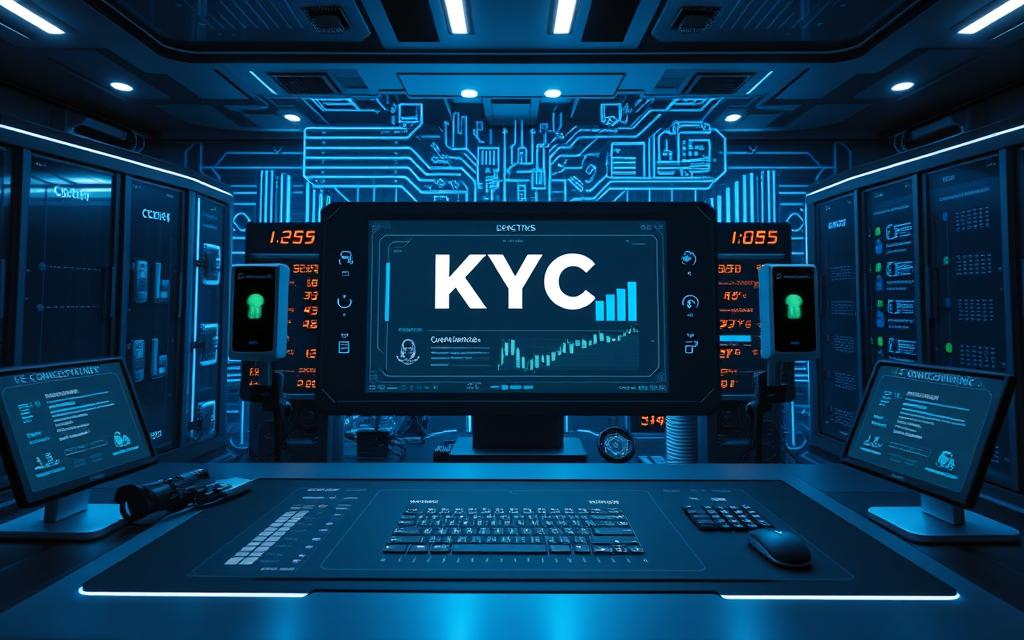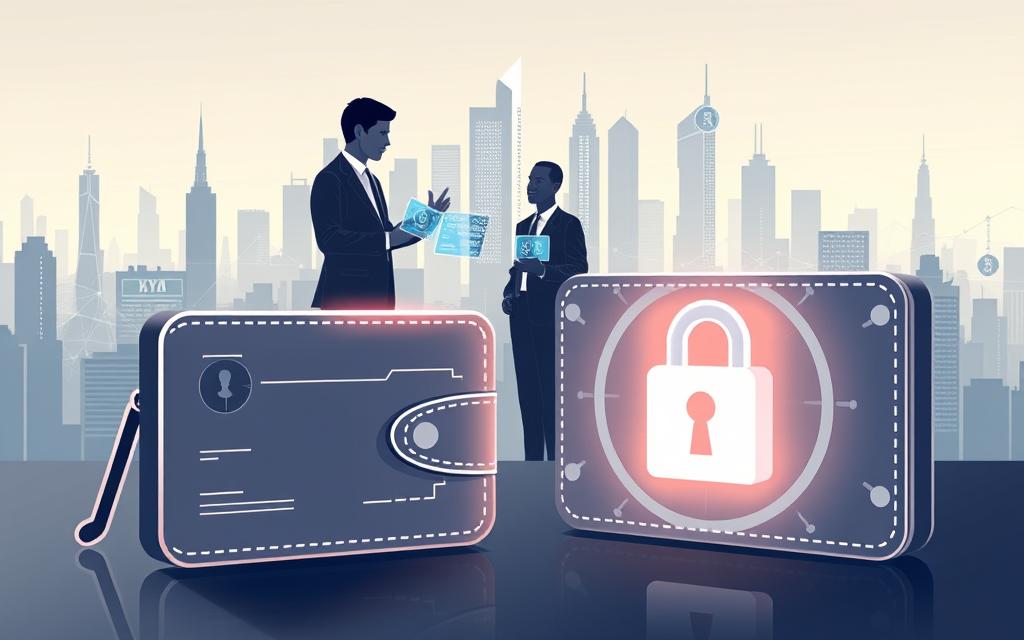Table of Contents
Regulatory frameworks shape the digital asset landscape, with Know Your Customer (KYC) protocols at the forefront. These measures verify user identities, ensuring transparency across exchanges and platforms. Financial Action Task Force (FATF) guidelines classify virtual asset service providers (VASPs) as entities requiring strict adherence.
Global standards vary—EU’s CASPs and US MSBs follow localized rules. Non-compliance risks penalties, like Coinbase’s £3.5M fine. Automated solutions now streamline verification, balancing security with user experience.
Fraud surged 48% in 2023, per Sumsub data, underscoring KYC’s role in fraud prevention. Institutional investors demand compliant platforms, reinforcing trust in cryptocurrency markets. Upcoming sections explore Travel Rule adoption and case studies.
What Is KYC Crypto? Understanding the Basics
Fraud prevention starts with validating user identities on blockchain platforms. Know Your Customer protocols ensure exchanges operate within legal boundaries while protecting users. These measures are not optional—they’re enforced by global watchdogs like the FATF.
Defining Verification in Digital Assets
Virtual Asset Service Providers (VASPs) must confirm identities before allowing transactions. This includes checking government IDs, proof of residence, and screening against sanctions lists. Unlike financial institutions, crypto platforms often require wallet addresses and transaction histories.
Traditional Finance vs. Digital Asset Checks
Banks rely on credit histories and SSNs. Crypto exchanges analyze blockchain activity. For example, UK regulators demand transaction hash verification, while Singapore focuses on Digital Payment Token (DPT) licenses. Centralized platforms perform Enhanced Due Diligence (EDD), whereas decentralized alternatives face compliance gaps.
Automation bridges this divide—Veriff’s 6-second verification shows how speed meets security. Learn more about evolving standards in our guide to KYC requirements.
Why KYC Compliance Is Critical for Crypto Exchanges
Global authorities are tightening oversight on digital asset platforms, making compliance non-negotiable. Failure to verify users exposes businesses to legal action and reputational damage. The 2024 UK case of a $1B laundering network underscores these risks.

Legal Requirements and Regulatory Frameworks
The FATF mandates a risk-based approach, requiring screening for politically exposed persons (PEPs) and sanctions lists. In the US, the Bank Secrecy Act (BSA) imposes fines up to $250K per violation. EU’s AMLD6 extends these requirements to decentralized platforms.
- Travel Rule thresholds: $1K+ in the US/EU vs. UK’s unlimited policy.
- Singapore revokes DPT licenses for non-compliant VASPs.
Risks of Non-Compliance for Crypto Platforms
Sumsub’s 2025 report reveals an 86% fraud spike in North America. Exchanges without proper checks lose correspondent banking access, crippling operations. Automation cuts costs by 43%, but gaps persist—79% of Middle Eastern fraud cases occurred despite KYC compliance.
“Unverified transactions attract illicit activity, eroding trust in blockchain ecosystems.”
Penalties range from fines to shutdowns, as seen with Coinbase’s £3.5M penalty. Proactive adoption of AML tools is now a survival tactic.
The KYC Process in Cryptocurrency: Step-by-Step
Modern platforms deploy multi-layered checks to validate users before granting transaction access. This structured approach balances regulatory demands with seamless onboarding, often completing in under a minute.
Identification and Document Submission
Platforms require government-issued IDs (passports, driver’s licenses) and proof of address, like utility bills. The UK’s Joint Money Laundering Steering Group mandates additional details, including tax codes and nationality, for enhanced scrutiny.
Centralized exchanges use this data to create risk profiles. Decentralized platforms, however, often lack standardized workflows, creating compliance gaps.
Verification and Liveness Checks
Biometric tools have evolved from static selfies to video-based gestures, countering deepfake threats. Sumsub’s median verification time is 50 seconds, while their Non-Doc option cuts this to 4.5 seconds.
Geo-location analysis ensures customers match claimed regions. Mismatches trigger manual reviews, reducing fraud by 63% according to 2024 data.
“Automated liveness checks now detect synthetic identities with 99.1% accuracy, redefining security benchmarks.”
Risk Scoring and Ongoing Monitoring
Algorithms analyze transaction patterns, flagging anomalies like rapid fund movements. High-risk users undergo Enhanced Due Diligence (EDD), as per FATF’s continuous CDD rules.
Automation reduces error rates by 37% compared to manual reviews. For deeper insights, explore this crypto KYC guide.
Key Components of a Robust KYC Program
Financial institutions and digital asset platforms rely on layered security protocols. These frameworks combine technology and regulatory adherence to protect businesses and users. Below are the core elements ensuring compliance and fraud prevention.

Customer Identification Program (CIP)
The USA PATRIOT Act mandates CIP for all financial entities, including crypto exchanges. Required data varies by region:
| Region | ID Requirement | Additional Checks |
|---|---|---|
| United States | SSN/Tax ID | OFAC sanctions screening |
| European Union | National ID | PEP lists, AMLD6 compliance |
| Singapore | NRIC/FIN | DPT license validation |
Automated tools like Veriff achieve 95% first-attempt verification success. Wallet screening adds another layer, flagging high-risk unhosted wallets.
Customer Due Diligence (CDD) and Enhanced Due Diligence (EDD)
Basic CDD verifies identity and transaction purpose. EDD applies to high-risk customers, such as:
- Politically exposed persons (PEPs)
- Users from sanctioned jurisdictions
- Large-volume traders
Blockchain analytics tools trace transaction patterns, while adverse media monitoring scans for red flags. FATF’s 2016 guidelines classify crypto businesses as high-risk, necessitating continuous CDD processes.
“EDD reduces money laundering risks by 72% in regulated platforms.” – FATF 2023 Report
These processes align with AML standards, creating a seamless compliance workflow for global operations.
Automated vs. Manual KYC: Pros and Cons for Crypto
Technology is reshaping identity verification in digital finance, offering faster and more secure solutions. Platforms now choose between AI-driven automation and traditional manual reviews, each with distinct trade-offs in speed, cost, and accuracy.
Benefits of Automated KYC Solutions
AI-powered tools slash verification times from 72 hours to 50 seconds, as seen with Sumsub’s 43% cost reduction. These systems excel in:
- Fraud prevention: Deepfake detection achieves 99.1% accuracy, countering 2024 synthetic identity attacks.
- Multi-protocol support: Integrated Travel Rule (TRP), GTR, and Sygna compliance streamline global operations.
- Scalability: APIs enable real-time checks for high-volume platforms without staffing spikes.
False positives drop by 37% with machine learning, ensuring smoother onboarding for legitimate users.
Challenges of Manual KYC Processes
Human reviews struggle with consistency and speed. A 23% fraud decline in APAC revealed a paradox—manual checks missed sophisticated schemes despite longer processing times.
Key pain points include:
- Legacy system gaps: 68% of traditional platforms lack API-ready infrastructure.
- Error rates: Subjective analysis leads to 15% higher false rejections than AI.
“Custom-built solutions often fail to match SDK reliability, as seen in 2023’s $200M compliance fines.”
While manual processes offer perceived control, automation delivers measurable compliance gains with fewer resources.
The Crypto Travel Rule and Its Connection to KYC
Global regulators are enforcing stricter data-sharing rules for crypto transfers. The Travel Rule mandates that Virtual Asset Service Providers (VASPs) exchange sender and receiver details for transactions exceeding $1K. This expands traditional KYC protocols, linking identity verification to fund movements.

How the Travel Rule Expands KYC Obligations
FATF requires originator and beneficiary data, including names, wallet addresses, and ID numbers. Unlike bank transactions, crypto transfers lack account numbers, forcing VASPs to adapt. Sumsub’s network of 1,700+ platforms reveals key workflow differences:
- Originating VASPs must collect and transmit data within 24 hours.
- Beneficiary VASPs verify received details against sanctions lists.
Turkey’s delayed implementation highlights interoperability hurdles between protocols like TRP and Sygna. Manual reviews spike costs by 68% for cross-border activities.
Compliance Challenges for VASPs
Unhosted wallets create gaps—31% of businesses lack tools to verify non-custodial addresses. Data fields vary: EU demands physical addresses, while the US accepts wallet hashes. Financial institutions often reject partnerships with non-compliant exchanges.
“Sunrise Periods allow phased adoption, but 2024 fines prove delays are costly.”
Automated solutions reduce errors, yet 5+ protocol standards fragment global regulations. The Travel Rule’s evolution will shape crypto’s trust landscape.
Benefits of KYC for Crypto Businesses and Users
Verified user bases transform how cryptocurrency businesses access global financial infrastructure. Beyond regulatory compliance, these protocols create measurable benefits, from fraud prevention to enhanced liquidity pools. Institutional adoption now hinges on platforms demonstrating robust identity verification frameworks.
Enhanced Security and Fraud Prevention
The 24,000% US crypto fraud surge (2016-2020) underscores why verification matters. Middle Eastern exchanges saw a 79% drop in illicit activities after implementing AI-powered checks. These systems deter criminals while preserving legitimate users’ anonymity through selective disclosure.

Advanced analytics flag suspicious patterns like rapid wallet funding. This proactive approach reduces chargebacks by 63% compared to unverified platforms, per 2024 Chainalysis data.
Building Trust with Financial Institutions
SWIFT requires verified user bases for fiat gateways—a key financing channel. Compliant exchanges gain:
- 43% lower insurance premiums (Lloyd’s 2023 underwriting criteria)
- Access to institutional custody services like Coinbase Prime
- 65% larger liquidity pools versus non-compliant DEXs
“User acquisition costs drop by 31% when platforms display TRUST badges from certified providers.”
These advantages create compounding returns, positioning verified platforms for sustainable growth in regulated markets.
Challenges of Implementing KYC in Crypto
Identity verification clashes with blockchain’s foundational privacy principles. While regulations demand transparency, many users value pseudonymity—creating friction in adoption. Africa’s 112% fraud surge (Sumsub 2025) underscores the stakes.
Balancing Anonymity and Compliance
GDPR’s “right to be forgotten” conflicts with immutable blockchain ledgers. Decentralized platforms resist IRS mandates, arguing they violate anonymity. EU metaverse proposals now demand avatar-linked IDs, further complicating the debate.
Proof-of-Work networks face higher energy costs for verification than PoS chains. This disparity forces exchanges to choose between sustainability and security.
High Costs and Operational Complexities
Mid-sized exchanges spend $250K+ annually on compliance processes. Staffing ratios of 1:500 compliance officers to users strain resources. Key pain points include:
- Cross-border data sharing: Conflicting laws between jurisdictions create legal gray zones.
- DeFi resistance: Automated protocols lack infrastructure for manual checks.
“Manual reviews increase operational overhead by 68%, yet gaps persist in detecting synthetic identities.”
These challenges highlight the need for scalable solutions that reconcile decentralization with regulatory realities.
The Future of KYC in Crypto: Trends and Predictions
Emerging technologies are redefining identity verification standards in decentralized finance. Regulatory bodies and innovators clash over balancing privacy with transparency, creating a dynamic landscape for compliance solutions.
Impact of DeFi and NFTs on Verification
The IRS now requires DeFi platforms to report transactions exceeding $10K, mirroring traditional finance rules. NFT marketplaces face pressure to verify creators, combating IP theft. Key shifts include:
- Self-Sovereign Identity (SSI): Expected mainstream adoption by 2027, enabling users to control data via blockchain wallets.
- NFT Royalties: Platforms like OpenSea may mandate creator KYC to enforce royalty payments.
AI and the Arms Race Against Deepfakes
Generative adversarial networks (GANs) create synthetic IDs that fool traditional checks. AI counters this with:
| Technology | Accuracy | Use Case |
|---|---|---|
| Liveness Detection | 99.3% | Blocks deepfake videos |
| Cluster Analysis | 91% | Identifies money mule networks |
Sumsub’s 2025 data shows a 200% spike in GAN-based fraud, pushing compliance teams to adopt real-time AI audits.
“Metaverse projects will test regulatory sandboxes, blending avatar identities with real-world KYC checks.”
Conclusion
Identity verification has evolved from traditional finance to a necessity in digital asset markets. Non-compliant platforms risk hefty fines, while those adopting automated solutions gain efficiency and trust.
Leading providers like Sumsub and Veriff set industry standards, countering threats like deepfakes. Emerging risks, including quantum computing, demand continuous innovation in compliance tools.
For exchanges, building partnerships with verified VASPs ensures long-term viability. The 2026 regulatory landscape points toward global standardization, making proactive adoption essential.
Stay ahead by integrating robust verification frameworks today. The balance between security and user experience will define tomorrow’s trusted platforms.
FAQ
How does KYC work in cryptocurrency exchanges?
Exchanges verify users’ identities by collecting documents like government-issued IDs, proof of address, and sometimes biometric data. This process helps prevent fraud and meet anti-money laundering (AML) regulations.
Why do crypto platforms require identity verification?
Financial regulators mandate KYC compliance to deter illicit activities like money laundering and terrorist financing. Verified users also gain higher transaction limits and stronger fraud protection.
What documents are needed for crypto KYC?
Most exchanges request a passport or driver’s license, recent utility bill or bank statement, and occasionally a selfie with the ID. Some platforms use liveness detection to confirm authenticity.
Can you trade crypto without completing verification?
Some decentralized exchanges allow limited trading without KYC, but regulated platforms block withdrawals until verification. Non-compliant services face shutdowns by financial authorities.
How long does the verification process typically take?
Automated systems approve accounts in minutes, while manual reviews may take 24-72 hours. Delays often occur from unclear documents or high applicant volumes during market surges.
What happens if a user fails KYC checks?
Exchanges must deny access or restrict features if verification fails. Users receive rejection reasons and may appeal with corrected documents, though repeated failures trigger permanent bans.
Do all jurisdictions have the same KYC requirements?
No, regulations vary globally. The EU’s AMLD5, US Bank Secrecy Act, and FATF guidelines set different standards. Exchanges often apply the strictest rules across all users.
How does KYC impact cryptocurrency privacy?
While reducing anonymity, KYC creates audit trails that protect legitimate users. Advanced platforms use zero-knowledge proofs to balance compliance with privacy where legally permitted.
Are there risks in sharing personal data with exchanges?
Reputable platforms encrypt sensitive information and comply with GDPR. Users should verify an exchange’s security certifications before submitting documents to prevent identity theft.
How often must users re-verify their identities?
Most exchanges require renewal every 1-3 years or after major account changes. Suspicious activity triggers immediate re-verification under enhanced due diligence protocols.









